
|
300C – THE BEAUTIFUL BRUTE
By Gil Cunningham
Reprinted
from the Spring 1981 Club News Volume VII Number III
which
was reprinted from the Club News Volume 1 No 3 April 1972
|

|
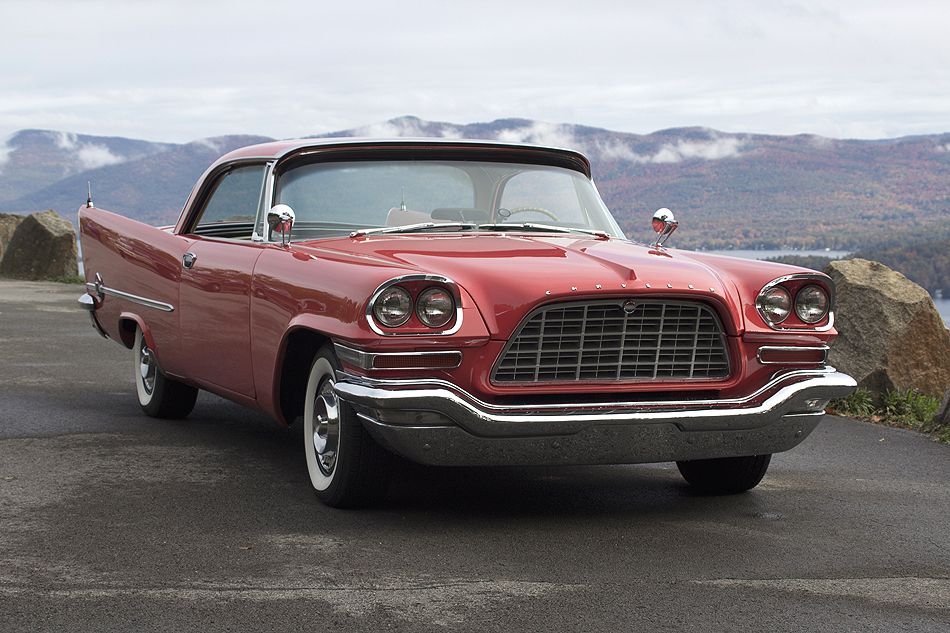
With the major changes on all 1957 Chrysler
Corporation cars came a radically revised 300 series automobile - -
the 300C. This car incorporated all the new features of the 1957
models; such as the torsion bar suspension, three-speed TorqueFlite
automatic transmission, 14” wheels, and the fabulous styling
which was to obsolete most other cars for the next several years, as
well as earn Virgil Exner the “Detroit Man of The Year”
award. In addition, for the first time in its history, a 300
convertible was available. Unfortunately, the 1957 models suffered
from some of the ills which result with accelerated design, testing,
and manufacturing schedules necessary for one company to get a “jump”
on the others. The wind noise, water leaks, rattles, and poor general
quality, especially in early models, were to haunt Chrysler
Corporation for several years to come. It is significant, however,
that magazine evaluations of the 300C generally reported high
quality. Two possible reasons for this can be proposed: a) The 300C
was a very high priced, (hardtop $4,864; convertible $5,294) limited
production vehicle which may have received extra attention, and b)
Volume production of 300Cs did not begin until December, 1956, three
months after 1957 model launch. By this time many production problems
would have been solved. However, a spirited drive in a 300C down a
challenging stretch of road would quickly dissipate any memories of
water leaks or wind noise, except for the very hardest to please.
There was really no other choice then when Motor Trend searched for a
recipient for its annual car of the year award. This award was, of
course, for the “Superior Handling and Roadability Qualities of
Their Plymouth, Dodge, DeSoto, Chrysler, and Imperial Cars.”
Styling of the 300C was very clean and simple by
1957 standards, and as such remains elegant today. The tailfins which
led the industry then were very well integrated into the design, as
well as providing
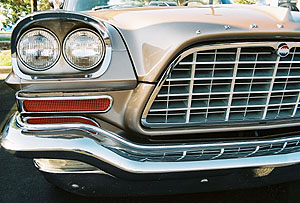
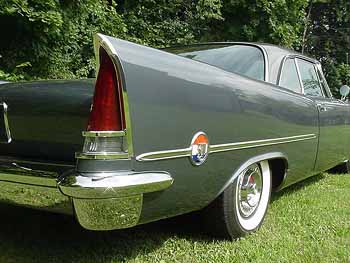 a steering correction reduction of 20% in
crosswinds.
Other styling features providing a most functional aspect
to the car were the unique brake cooling ducts and the brutish open
grille supplying a maximum amount of air to the radiator. In fact,
the front of the 300C was taken straight from Styling Car No. 613,
Virgil Exner’s idea of a man’s sport car. a steering correction reduction of 20% in
crosswinds.
Other styling features providing a most functional aspect
to the car were the unique brake cooling ducts and the brutish open
grille supplying a maximum amount of air to the radiator. In fact,
the front of the 300C was taken straight from Styling Car No. 613,
Virgil Exner’s idea of a man’s sport car.
Several present
day cars appear to be attempting to copy the 300C grille design, but
they have more work to do before the correct combination of shape and
angle is obtained. It was no wonder, then, that the 300C received the
award in 1957 for the “outstanding example of modern
architecture.”
In addition to the revolutionary styling changes
for 1957, the 300 medallion was redesigned to a circle incorporating a red, white, and blue background over which was placed the 300C
designation. According to a Chrysler release of that time, “It
is intended to remind people that this is truly an American car. We
use the circle because what makes a car different from a boat or
plane is the circle of the wheel.”
a red, white, and blue background over which was placed the 300C
designation. According to a Chrysler release of that time, “It
is intended to remind people that this is truly an American car. We
use the circle because what makes a car different from a boat or
plane is the circle of the wheel.”
This medallion motif is by
far the best recognized of all, and survived on the letter series
through 1962.
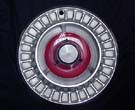 Wheelcovers for the 300C were taken straight from
the 1957 LeBaron, the only difference being the red paint around the
center spinner. This fact is salvation to many of us latter day
collectors frantically hunting these covers for our “BRUTE.”
Some early cars evidently came with stock LeBaron covers. The white
convertible on the cover of Motor Trend, March 1957, is so equipped,
as is the car (#3N571292) of one of our members, Mr. George Riehl.
Wheelcovers for the 300C were taken straight from
the 1957 LeBaron, the only difference being the red paint around the
center spinner. This fact is salvation to many of us latter day
collectors frantically hunting these covers for our “BRUTE.”
Some early cars evidently came with stock LeBaron covers. The white
convertible on the cover of Motor Trend, March 1957, is so equipped,
as is the car (#3N571292) of one of our members, Mr. George Riehl.
On the interior, many changes were evident in
comparison to the previous year’s 300B. The rich pleated
leather upholstery garnered praise from all automotive writers. No
other car had seats like these. New for 1957 also, were 300 numerals
on the inside of the car, an embossment barely visible above the
center of the back seat, silver colored appliques on each door trim
panel, and the red, white, and blue medallion on the glove box door
and horn button. The door trim panel 300 applique on earlier models
had no rectangular border, whereas later cars did. Arm rest plastic
supports were black on very early cars (ref.: 300C test, Motor Trend,
March, 1957; 300C advertising brochure) but were shortly changed to
matching tan.
The 300C was available in five (5) solid cars, up
from three (3) in 1956. Two metallic colors, Parade Green and Copper
Bronze, were offered as well as straight shades of Gaugin Red, Cloud
White, and Jet Black. However, it would appear that special orders
could occasionally be obtained if the purchaser had the money and/or
influence. One of our members owns a 300C painted a dark metallic
blue (coded “Z” on the body plate) and equipped with a
single carburetor New Yorker engine! He has verified this with the
original owner to be the way the car was ordered and delivered.
As most readers are probably aware, the standard
300C engine was the 392 cu. in. Firepower unit rated at 375 HP @ 5200
RPM and 420 ft-lbs of torque at 4000 RPM. However, an optional engine
of even more impressive specifications was available; 390 HP @
5400RPM and 430 ft-lbs of torque at 4200 RPM. This engine was
available at extra cost as part of the optional chassis package which
included limited slip differential, low back pressure exhaust system,
manual transmission, manual steering, and manual brakes.
The horsepower increase was obtained by increasing
the compression ratio (milled heads) and a camshaft change. Below is
a quick comparison between these two 300C engines:
|
|
375 HP
|
390HP
|
|
Compression ratio
|
9.25/1
|
10.0/1
|
|
Camshaft Part No.
|
1731569
|
1821255
|
NA
|
|
Intake Duration
|
2800
|
3000
|
2550
|
|
Exhaust Duration
|
2700
|
3000
|
2600
|
|
Overlap
|
600
|
950
|
400
|
|
Lift
|
.444” Intake
|
.445” Intake
|
.445” Intake
|
|
.435” Exhaust
|
.447” Exhaust
|
.445” Exhaust
|
There is some confusion regarding which optional
camshaft was actually used in the 390 engine. Perhaps both were at
different times. The 3000 camshaft was released for the
first optional engines, while the 2550 cam is listed in
the AMA specs, dated 2-4-57. As more reliable information
is obtained on these camshafts, it will be published. Holley
carburetors were also listed as options on the 300C engine in the
1957 AMA specification sheets. However, Mr. Gene Carr, Chrysler
engineer who worked with engines at that time, indicated that space
consideration made their usage impractical. Those of us who have
adjusted the front carburetor idle screws or tried to set ignition
points with the distributor still in the car will attest to the
cramped quarters, even with the Carters! I have not been able to
determine accurately how many 390 HP engines were installed in the
300Cs, but most guesses by Chrysler personnel vary from 20 to 50.
The special low back pressure exhaust system
consisted of 2 ½” diameter exhaust pipes, exhaust
extensions, mufflers, and tailpipes. The exhaust manifolds were from
Dodge trucks and had 4 bolt flanges, as did the special exhaust
pipes. These exhaust systems were used at Daytona and allowed the
already potent 300 engine to really breathe and achieve speeds in the
range of 140 MPH.
The limited slip differential, manual brakes and
manual transmission had no special distinguishing characteristics
other than the clutch was eleven inches in diameter rather than the
ten inch unit used on Windsors. Total plate pressure was about 15%
higher.
As was mentioned earlier, all information
available stipulates the 390 HP engine was only obtained with the
optional chassis package. However, I have personally seen and ridden
in one of the 300Cs which ran at Daytona (#3N571164) and this car had
an automatic transmission. It would seem that, as with other aspects
of 300s, what was officially released did not always appear in that
combination on the vehicle. Some race drivers preferred their cars
equipped with power steering to achieve the quicker ratio. They then
disconnected the pump to save power! Driving one of those took
muscles.
Performance of the 300C was fantastic by 1957
standards and is exceptional (and getting more so) by today’s
standards. All automotive writers had a “field day” with
it and were generally lavish in their praise. The only consistent
criticism on performance was with the brakes, which admittedly had a
big job to do. By 1957 standards they were average, but will not
compare at all favorably to today’s disc-drum units, especially
in fade resistance. In the chart below are summarized some of the
published road test results on the 300C:
|
|
Sports Cars Illustrated
|
Motor Trend
|
Mechanix Illustrated
|
Chrysler Proving Grounds
|
|
0-30
|
3.7 sec.
|
3.1 sec.
|
3.7 sec.
|
3.2 sec.
|
|
0-60
|
9.2 sec.
|
8.0 sec.
|
8.4 sec.
|
8.6 sec.
|
|
¼ Mile E.T.
and speed
|
16.9 sec.
84 MPH
|
N.A.
|
N.A.
|
16.3 sec.
84 MPH
|
|
Top Speed
|
140 est.
|
140 est.
|
134 MPH
|
125.1 MPH
|
|
Test Weight
|
4745 lb.
|
N.A.
|
4235 lb.
|
4825 lb.
|
|
Body Style
|
Convert.
|
Hardtop
|
Hardtop
|
Hardtop
|
|
Axle Ratio
|
3.36/1
|
3.36/1
|
3.18/1
|
3.36/1
|
The Chrysler Proving Ground ran top speed tests on
the 300C in November of 1956. Speeds in the 145 mph range were
obtained; however, drag reducing shields were used over the
headlights and above the windshield. Removal of these shields
resulted in a speed reduction of about 6 mph. These runs were also
made without air cleaners, mufflers, or tailpipes and with 60 PSI
tire pressures. 3.18/1 or 2.92/1 gears produced virtually the same
speeds. So it would not be reasonable to assume that one could
duplicate these speeds in his restored, streetable 300C. The 300 was
again the fastest sedan at Daytona, but its top speed of 134.1 mph
was not equal to that attained by the 300B in 1956. The price of the
rugged, masculine, but wind resistant front end styling was being
paid. Though the 300C was groomed as the successor to the 300B on the
stock car circuit, it will never be known actually how well it would
have done. In June of 1957, the AMA banned open factory participation
in racing. Except for the annual Daytona speed trials, real high
speed competition was a thing of the past for the 300.
2188 examples of the 300C were built, 1714 of
which were hardtops and 474 convertibles. (Editors’ Note: Since
this article was written, these numbers have been disputed. Research
is underway to come up with correct figures.)
Below is shown the serial number of the first 300C
built in each month of its production:
|
Month/Year
|
Starting
Serial Number
|
|
September, 1956
|
3N571001
|
|
October, 1956
|
3N571003
|
|
November, 1956
|
None Built
|
|
December, 1956
|
3N571004
|
|
January, 1957
|
3N571055
|
|
February, 1957
|
3N571339
|
|
March, 1957
|
3N571631
|
|
April, 1957
|
3N571957
|
|
May, 1957
|
3N572332
|
|
June, 1957
|
3N572715
|
|
July, 1957
|
3N573065
|
|
August, 1957
|
3N573181
|
Fortunately, production of the 300C was a record
for pure type 300s, so a relatively large number still exist. The car
was a masterful combination of performance, handling, and the epitome
of brutish, masculine looks. I am guilty of some prejudice, since my
first 300 was a “C” which I have owned for almost 9
years, and have yet to find its equal. I am confident, however, that
many readers will share my slightly biased feelings. The 300C image,
more than that of any other 300, contributed to the epithet applied
by Mr. Bill Carroll to all 300s, for the 300C was truly a “BEAUTIFUL
BRUTE!”
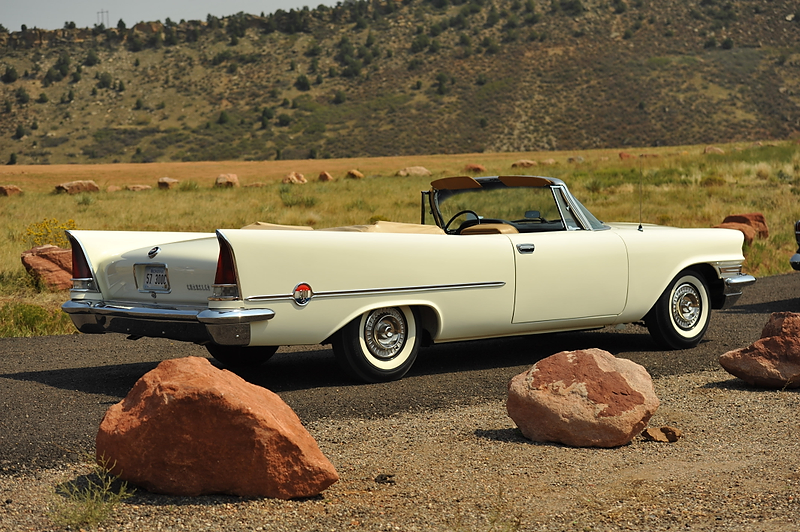
Back
|
|